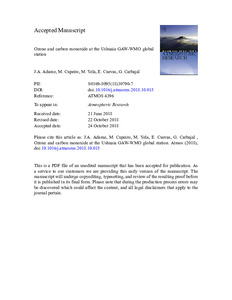Por favor, use este identificador para citar o enlazar este ítem:
https://repositorio.uca.edu.ar/handle/123456789/14708| Título: | Ozone and carbon monoxide at the Ushuaia GAW-WMO global station | Autor: | Adame, José Antonio Cupeiro, Yela, Margarita Cuevas, Emilio Carbajal, G. |
Palabras clave: | MONOXIDO DE CARBONO; OZONO SUPERFICIAL; VIENTO | Fecha de publicación: | 2019 | Editorial: | Elsevier | Cita: | Adame, J. A. et al. Ozone and carbon monoxide at the Ushuaia GAW-WMO global station [en línea]. Atmospheric Research. 2019, 217. doi:10.1016/j.atmosres.2018.10.015 Disponible en: https://repositorio.uca.edu.ar/handle/123456789/14708 | Resumen: | Abstract: Five years (2010-2014) of hourly surface measurements of ozone (O3) and carbon monoxide (CO) at the GAW-WMO station in Ushuaia (Argentina) were analysed and characterised. A meteorological study of the region was carried out using in situ observations and meteorological fields from the ECMWF (European Centre for Medium-Range Weather Forecast) global meteorological model. Atmospheric transport was investigated with the air mass trajectories computed with HYSPLIT (Hybrid Single Particle Lagrangian Integrated Trajectory) model using ERA-Interim meteorological fields. Airflows primarily arise from the W-SW (South Pacific Ocean) which are associated with an almost permanent low pressure system. Collected winds from the South (Antarctic Peninsula and Weddell Sea), polar easterlies, occur less frequently. The hourly averages of O3 and CO were 20±7 ppb and 71±45 ppb, respectively, typical values in remote environments. A clear seasonal pattern was obtained for O3, with a monthly peak in winter of 25 ppb and minimum in summer of 12 ppb. Similar behaviour was found for CO, with 93 and 48 ppb maximum and minimum values, respectively. Both species show a weak daily cycle with an amplitude of 2-4 ppb for O3 and 13-20 ppb for CO. Peaks in O3 and CO in the cold season could be associated with low photochemical activity, fewer destructive processes and transport of these species from the South Pacific. O3 vertical behaviour was analysed using 139 O3 soundings at Ushuaia in the period studied. The seasonal patterns and levels of the O3 profiles from the surface up to 5 km are similar to measurements on surface and thus it can be assumed that the O3 measured on the surface could be representative of the low-mid troposphere. To investigate the spatial distribution of O3 and CO in this region and the spatial representativeness of the Ushuaia measurements, daily observations from the AIRS (Atmospheric Infrared Sounder) instrument on board the AQUA satellite were used. The results obtained show that the O3 levels in Ushuaia could be representative of a wide region in the Pacific South and that the CO levels are representative of a continental region around the observatory. | Cobertura Espacial: | Ushuaia, Argentina | URI: | https://repositorio.uca.edu.ar/handle/123456789/14708 | ISSN: | 0169-8095 | Disciplina: | INGENIERIA AMBIENTAL | DOI: | 10.1016/j.atmosres.2018.10.015 | Derechos: | Acceso abierto | Fuente: | Atmospheric Research. 2019, 217 |
| Aparece en las colecciones: | Artículos |
Ficheros en este ítem:
| Fichero | Descripción | Tamaño | Formato | |
|---|---|---|---|---|
| ozone-carbon-monoxide.pdf | 9,1 MB | Adobe PDF |  Visualizar/Abrir |
Visualizaciones de página(s)
81
comprobado en 27-abr-2024
Descarga(s)
56
comprobado en 27-abr-2024
Google ScholarTM
Ver en Google Scholar
Altmetric
Altmetric
Este ítem está sujeto a una Licencia Creative Commons

